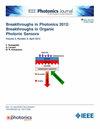Numerical Simulation of Performance Improvement of Coherent LiDAR Based on SPGD Algorithm
IF 2.4
4区 工程技术
Q3 ENGINEERING, ELECTRICAL & ELECTRONIC
引用次数: 0
Abstract
Atmospheric turbulence can significantly impact the effectiveness of light detection and ranging (LiDAR) in long-range detection. A technique for wavefront correction, which is based on the stochastic parallel gradient descent (SPGD) optimization algorithm, is proposed. The method integrates coherent detection theory with adaptive optics technology, effectively mitigating the adverse effects of turbulence. This work evaluates the suitability of the algorithm in coherent LiDAR through theoretical analysis and establishes the necessary theoretical relationships. Through numerical simulation, we assess its optimization ability for Strehl ratio (SR), bit error rate (BER), signal to noise ratio (SNR), and detection distance (DR). We also conduct a comprehensive analysis of the impact of the number of iterations of the algorithm affecting SR, SNR, and DR. This analysis provides robust data support for balancing the performance of the system. The results show that the corrected SR can reach 0.96, 0.88, and 0.75, the SNR can be improved by 7 dB, 16 dB, and 26 dB, and the DR can be improved by 8%, 17%, and 30% in gentle, moderate, and strong turbulence, respectively.基于 SPGD 算法的相干激光雷达性能改进数值模拟
大气湍流会严重影响光探测与测距(LiDAR)的远距离探测效果。本文提出了一种基于随机平行梯度下降(SPGD)优化算法的波前校正技术。该方法将相干探测理论与自适应光学技术相结合,有效地减轻了湍流的不利影响。这项工作通过理论分析评估了该算法在相干激光雷达中的适用性,并建立了必要的理论关系。通过数值模拟,我们评估了该算法在斯特雷尔比(SR)、误码率(BER)、信噪比(SNR)和探测距离(DR)方面的优化能力。我们还全面分析了算法迭代次数对 SR、SNR 和 DR 的影响。该分析为平衡系统性能提供了可靠的数据支持。结果表明,在平缓、中等和强湍流情况下,修正后的 SR 可分别达到 0.96、0.88 和 0.75,SNR 可分别提高 7 dB、16 dB 和 26 dB,DR 可分别提高 8%、17% 和 30%。
本文章由计算机程序翻译,如有差异,请以英文原文为准。
求助全文
约1分钟内获得全文
求助全文
来源期刊

IEEE Photonics Journal
ENGINEERING, ELECTRICAL & ELECTRONIC-OPTICS
CiteScore
4.50
自引率
8.30%
发文量
489
审稿时长
1.4 months
期刊介绍:
Breakthroughs in the generation of light and in its control and utilization have given rise to the field of Photonics, a rapidly expanding area of science and technology with major technological and economic impact. Photonics integrates quantum electronics and optics to accelerate progress in the generation of novel photon sources and in their utilization in emerging applications at the micro and nano scales spanning from the far-infrared/THz to the x-ray region of the electromagnetic spectrum. IEEE Photonics Journal is an online-only journal dedicated to the rapid disclosure of top-quality peer-reviewed research at the forefront of all areas of photonics. Contributions addressing issues ranging from fundamental understanding to emerging technologies and applications are within the scope of the Journal. The Journal includes topics in: Photon sources from far infrared to X-rays, Photonics materials and engineered photonic structures, Integrated optics and optoelectronic, Ultrafast, attosecond, high field and short wavelength photonics, Biophotonics, including DNA photonics, Nanophotonics, Magnetophotonics, Fundamentals of light propagation and interaction; nonlinear effects, Optical data storage, Fiber optics and optical communications devices, systems, and technologies, Micro Opto Electro Mechanical Systems (MOEMS), Microwave photonics, Optical Sensors.
 求助内容:
求助内容: 应助结果提醒方式:
应助结果提醒方式:


